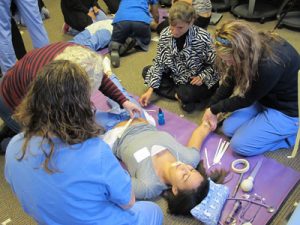An interactive, multisensory workshop simulating the premature birth experience from the baby’s point of view has our Newborn Critical Care Center nurses rethinking how to provide the best care to our tiniest, most fragile patients.

An interactive, multisensory workshop simulating the premature birth experience from the baby’s point of view has our Newborn Critical Care Center nurses rethinking how to provide the best care to our tiniest, most fragile patients.
 Article by: Diane Hudson-Barr, PhD, RN, Clinical Nurse Specialist, Neonatal Developmental Care Specialist; Sarah Kenney, March of Dimes NICU Family Support Specialist; and Jennifer Flippin, RN, BSN, RNC-NIC, Nurse Manager, Newborn Critical Care Center
Article by: Diane Hudson-Barr, PhD, RN, Clinical Nurse Specialist, Neonatal Developmental Care Specialist; Sarah Kenney, March of Dimes NICU Family Support Specialist; and Jennifer Flippin, RN, BSN, RNC-NIC, Nurse Manager, Newborn Critical Care Center
First it’s quiet. You’re in a warm, safe, comfortable environment. Then, in an instant, you’re thrust into complete chaos. Bright lights. Loud noises. People touching you.
This is how premature babies experience birth. Nurses from the Newborn Critical Care Center (NCCC) at N.C. Children’s Hospital recently participated in a simulated premature birth experience during “Preemie for a Day,” sponsored by the March of Dimes. The four-hour workshop gave the nurses a unique opportunity: experiencing delivery from the baby’s point of view.
“The presenters, a NICU registred nurse and pediatric occupational therapist, began the program with a review of the baby’s normal development in utero and how exposure to the light, sounds, smells and healthcare provider touch can alter ongoing development of a premature baby,” explains Jennifer Flippin, RN, BSN, RNC-NIC, NCCC nurse manager. “The presenters facilitated discussion about strategies that could be used in everyday practice to promote optimal neurosensory development for the babies.”
After the introductory discussion, nurses moved to the hands-on session of the workshop. Five nurses volunteered to play the role of newborn preemies. These nurses went into a different room with dimmed lights and listened to sounds recorded from the womb. They were asked to curl up in their most comfortable position. The other participants formed five care teams. They were instructed to mimic the admission process, and dramatically interrupted the calm and quiet environment of the volunteer preemies.
The adult preemies were first restrained, their arms and legs taped to the mattress. Then came the “intubation” with straws taped to their faces. The nursing teams prepared IVs with cold alcohol wipes and “inserted” a straw IV taped to a board for securing. The preemies had their temperature taken under the arm using a cold metal rod that had not been pre-warmed. Their heartbeats were assessed using a cold stethoscope.
All every day things done for a baby admitted to an ICU.
After the hands-on activity, each of the preemies took a turn to tell the other participants how the experience felt to them. They described how startled they were, how overwhelmed they felt and how threatening the experience was to them.
“Hearing those feelings from the preemie volunteers helped the nurses to better understand how traumatic the admission process is for critically ill babies,” says Jennifer Flippin. “As participants left the workshop, you could hear them talking about ways they would change their practice to be more developmentally supportive of the babies. This is exactly the outcome that the organizers had hoped for.”